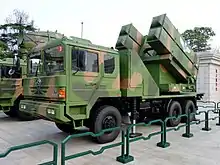HQ-6
The HQ-6, also known as LY-60 (NATO reporting name: CH-SA-6[1]), is a family of Chinese air defense missiles developed by the Shanghai Academy of Science and Technology, largely based on the Chinese PL-11 and Italian Selenia (now as Leonardo S.p.A.) Aspide missile.
| HQ-6 | |
|---|---|
 HQ-6A Surface-to-air missiles mounted with road-mobile launcher | |
| Type | air-to-air & surface-to-air missiles |
| Place of origin | China |
| Service history | |
| In service | late 1980s – present |
| Used by | Primary user: China See Operators section for others |
| Production history | |
| Manufacturer | Shanghai Academy of Science and Technology |
| Produced | since late 1980s |
| Specifications | |
| Mass | 220 kg |
| Length | 3.69 meter |
| Diameter | 203 mm |
| Warhead | 33 kg warhead |
Detonation mechanism | impact / proximity |
| Engine | rocket motor |
| Propellant | solid fuel |
Operational range | 18 km for SAM, 60 km for AAM |
| Maximum speed | Mach 3 |
Guidance system | SARH / ARH |
Launch platform | Air & surface |
Development
HQ-6 is a surface-to-air missile system developed by the Shanghai Academy of Science and Technology, incorporating technologies from PL-11 missile. PL-11 is the license-produced version of Aspide missile, which itself is based on the American AIM-7 Sparrow missile. It was speculated the missile is a copy of AIM-7 when the system was revealed in the late 1970s, though HQ-6 is considerably larger than the AIM-7 Sparrow.[2] HQ-6 missile went through multiple iterations, and an export variant named LY-60 was also developed.
Variants
PL-11
The PL-11 (Chinese: 霹雳-11; pinyin: Pī Lì-11; lit. 'Thunderbolt-11') is a medium-range semi-active radar homing (SARH) air-to-air missile (AAM) developed by a subsidiary of the Shanghai Academy of Spaceflight Technology in the People's Republic of China. It is a derivate or copy of the Italian Aspide air-to-air missile, which in turn was developed from the American AIM-7 Sparrow. PL-11 is not officially a part of the HQ-6 surface-to-air missile family, but it serves as the technology base for the HQ-6.[3]
HQ-61

.JPEG.webp)
The HQ-61 (simplified Chinese: 红旗-61; traditional Chinese: 紅旗-61; pinyin: Hóng Qí-61; lit. 'Red Banner-61') is the first member of the HQ-6 missile family. The entire SAM system consists of four truck-mounted radars (one search/surveillance radar and three tracking/fire control radars), one power supply truck, and six transporter erector launchers (TEL). The missile itself is directly derived from the air-to-air version PL-11. But unlike the Italian Aspide which uses containers as launchers, HQ-6 uses missile launching rails (MLR) instead, and each truck-mounted launcher has two missile rails. Specifications:[4]
- Length: 3.99 m
- Diameter: 286 mm
- Wingspan: 1 m
- Weight: 300 kg
- Speed: Mach 3
- Maximum maneuvering overload: 35G
- Maximum maneuvering overload [interception]: 7G
- Range: 30m to 8 km (altitude), 10 m to 10 km (slant)
- Guidance: Semi-Active Radar Homing
The HQ-61 was deployed on Type 053H2G frigate Jiangwei I frigate of the People's Liberation Army Navy Surface Force. The HQ-61 was equipped on four Type 053H2G built between 1988 and 1991. The capability of the missile was questioned by the Chinese Navy, and the missile system was eventually replaced by the HQ-7 air defense system.[5]
LY-60
In October 1994, China unveils a new medium-low-altitude surface-to-air missile system named LY-60 (Chinese: 猎鹰-60; pinyin: Lieying-60; lit. 'Falcon-60'). LY-60 was designed to intercept military aircraft and missiles flying in medium to low altitudes. To improve anti-jamming capability, the command control system features a unique artificial interference system due to its improved microprocessor, never seen before in contemporary medium-low-altitude air defense missiles. The search radar of the LY-60 can track up to 40 targets simultaneously, and the tracking radar is able to simultaneously track 12 targets, and engage three targets at once.[6]
HQ-64

The HQ-64[7] is an improved version of the HQ-61, incorporating experience and technologies gained from the LY-60 project. When paired with a command vehicle, the system is called HQ-6D air defense system.[8] The firepower is doubled by increasing the number of missiles for each truck mounted launcher from two to four, and by replacing the launching rails with container box launchers, the reliability is also increased. Both the missile and transporter vehicles are directly developed from the LY-60 system. The missile is smaller than that of the HQ-6, yet the performance is enhanced due to technological improvements. HQ-64 passed the state certification test and was accepted into Chinese service in 2001.[9]
Each command vehicle is able to command & control up to four HQ-64 batteries,[10] linking up independent HQ-64 batteries to form an integrated air defense net work, and individual HQ-64 network can in turn be integrated into a larger air defense zone. The field deployment time of HQ-64 SAM system is 9 to 15 minutes.[11][12] Specifications:[4]
- Length: 3.89 m
- Diameter: 203 mm
- Weight: 220 kg
- Speed: Mach 3
- Range: 30m to 12 km (altitude), 10 m to 18 km (slant)
- Guidance: Semi-Active Radar Homing
References
- "6 Asia". The Military Balance 2023. 15 February 2023.
{{cite book}}:|work=ignored (help) - "中国霹雳系列空空导弹发展历程". sina news. 12 June 2010.
- Wood, Yang & Cliff 2020, p. 37-38.
- "迟到的利器——试析军演中的红旗6D防空导弹". www.zgjunshi.com. Archived from the original on 2012-03-30. Retrieved 2011-08-14.
- Toppan, Andrew. "World Navies Today: Chinese Surface Combatants." Haze Gray & Underway.2002-03-24. Retrieved 2011-05-10.
- "LY-60". globalsecurity.
- "解放军装备的新型红旗-6D防空导弹". Sina News.
- "HQ-6D Chinese Surface-to-Air Missile System". US Army TRADOC.
- "红旗6(红旗61/红旗63/红旗64)中低空防空导弹". www.zgjunshi.com. Archived from the original on 2012-03-30. Retrieved 2011-08-14.
- "成空地空导弹旅列装国产红旗-6D新型导弹9分钟完成战斗准备_007兄弟_新浪博客". blog.sina.com.cn. Archived from the original on 2012-10-20. Retrieved 2011-08-14.
- "成空列装新型红旗-6D防空导弹 9分钟完成战斗准备_军事频道_凤凰网". news.ifeng.com. Archived from the original on 2011-08-31. Retrieved 2011-08-14.
- "HQ-6D exercise" Archived 2011-07-13 at the Wayback Machine
- "红旗6A为何如此奇特 一套武器竟有三辆车分开运载". Sina News.
- "Trade Registers". armstrade.sipri.org.
- 19960619, National Air Intelligence Center (NAIC): "Lieh Ying: The Chinese-built Surface to Air Missile Weapon System", An Hua, NAIC-ID(RS)T-0253-96
Bibliography
- Wood, Peter; Yang, David; Cliff, Roger (November 2020). Air-to-Air Missiles: Capabilities And Development In China (PDF). Montgomery: China Aerospace Studies Institute. ISBN 9798574996270.